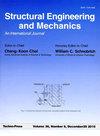Study on the mechanical behaviors of timber frame with the simplified column foot joints
IF 2.2
4区 工程技术
Q2 ENGINEERING, CIVIL
引用次数: 3
Abstract
Column foot in traditional Chinese timber structures may be subjected to be uplifted due to the lateral load and subsequently reset under the vertical loads. The residual moment of the rocking column foot is the most important parameter representing the mechanical behaviors of column foot, and the simplification of joints is the basis of structural analysis of whole structure. The complicated mechanical behaviors of joint and the modeling of the column foot joint has been undertaken historically based on the experiments and numerical simulation. On the condition of limited application range of those models, a lack of simplified model to represent the mechanical behaviors of joint deserves attentions. There is a great need to undertake theoretical studies to derive the residual moment and make better simplified model of the joint. This paper proposes the residual moment and equivalent simplified model of the rotational stiffness for column foot joint. And, the timber frame is established based on the simplified model, which is verified by solid finite element model. Results show that a mutual agreement on the mechanical behaviors of the timber frame is obtained between the simplified model and the solid finite element model. This study can serve as the references of the structural analysis for the traditional timber structures.简化柱脚节点木结构框架受力性能研究
中国传统木结构的柱脚可能会在横向荷载作用下被抬升,然后在竖向荷载作用下复位。柱脚的残余弯矩是表征柱脚力学行为的最重要参数,节点的简化是整个结构分析的基础。在试验和数值模拟的基础上,对节点复杂的力学行为和柱脚节点的建模进行了历史性的研究。在这些模型适用范围有限的情况下,缺乏能反映关节力学行为的简化模型值得关注。因此,有必要进行理论研究,推导出该节点的残余弯矩,并建立更好的简化模型。本文提出了柱脚节点转动刚度的剩余弯矩和等效简化模型。并基于简化模型建立了木结构框架,并用实体有限元模型进行了验证。结果表明,简化模型与实体有限元模型对木结构框架的受力性能具有较好的一致性。本研究可为传统木结构的结构分析提供参考。
本文章由计算机程序翻译,如有差异,请以英文原文为准。
求助全文
约1分钟内获得全文
求助全文
来源期刊

Structural Engineering and Mechanics
工程技术-工程:机械
CiteScore
3.80
自引率
18.20%
发文量
0
审稿时长
11 months
期刊介绍:
The STRUCTURAL ENGINEERING AND MECHANICS, An International Journal, aims at: providing a major publication channel for structural engineering, wider distribution at more affordable subscription rates; faster reviewing and publication for manuscripts submitted; and a broad scope for wider participation.
The main subject of the Journal is structural engineering concerned with aspects of mechanics. Areas covered by the Journal include:
- Structural Mechanics
- Design of Civil, Building and Mechanical Structures
- Structural Optimization and Controls
- Structural Safety and Reliability
- New Structural Materials and Applications
- Effects of Wind, Earthquake and Wave Loadings on Structures
- Fluid-Structure and Soil-Structure Interactions
- AI Application and Expert Systems in Structural Engineering. Submission of papers from practicing engineers is particularly encouraged.
 求助内容:
求助内容: 应助结果提醒方式:
应助结果提醒方式:


